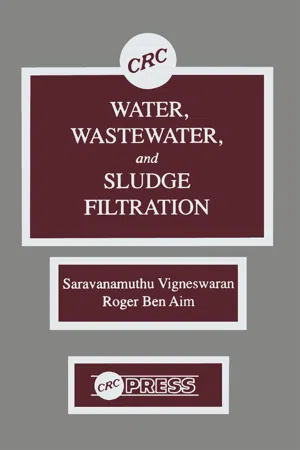
- 296 pages
- English
- ePUB (mobile friendly)
- Available on iOS & Android
Water, Wastewater, and Sludge Filtration
About This Book
A comprehensive and up-to-date account of filtration in solid-liquid separation processes, with a sharp focus on the influence of pro-cess variables on performance and specific applications is pre-sented in this volume. With contribu-tions from researchers with significant industrial experi-ence, as well as by senior academics, this publication fea-tures a deep bed filtration overview with informa-tion on mathematical modeling and application in wastewater treat-ment. Pre-treatment filtration techniques such as cartridge filters, pre-coat filters and micro screening are included. Membrane filtration processes to remove dis-solved and suspended solids for the recovery of valuable ma-terials and the provision of high quality water are covered. Sludge de-watering methods such as centrifuga-tion, and vacuum and pressure filtration are described. Application status data, tables, figures and diagrams are also included. This volume is of special interest to practicing engineers and technolo-gists dealing with treatment problems requiring filtration solu-tions and to graduate students in environmental engineering.
Frequently asked questions
Information
Chapter 1
OVERVIEW OF DEEP BED FILTRATION: DIFFERENT TYPES AND MATHEMATICAL MODELS
Saravanamuthu Vigneswaran and Roger Ben Aim
I. | Introduction |
II. | Improvements on Rapid Filter A. Improvements on Filter Media B. Improvements on Flow Rate C. Elimination of Some Operations from Conventional Water Treatment |
III. | Filter Backwash Methods A. Choice of Backwash Method B. Backwashing with Effluent from Other Filter Units |
IV. | Optimization of Filter Design |
V. | Mathematical Models A. Filtrate Quality B. Headloss 1. Clean Bed 2. Clogged Bed |
References | |
I. INTRODUCTION
II. IMPROVEMENTS ON RAPID FILTER
A. Improvements on Filter Media
B. Improvements on Flow ...
Table of contents
- Cover
- Title Page
- Copyright Page
- Preface
- The Editor
- Contributors
- Table of Contents
- Chapter 1 Overview of Deep Bed Filtration: Different Types and Mathematical Models
- Chapter 2 Theoretical Approach of Deep Bed Filtration
- Chapter 3 Direct Filtration
- Chapter 4 Applications of Deep Bed Filtration in Wastewater Treatment
- Chapter 5 Microstraining
- Chapter 6 Precoat Filtration
- Chapter 7 Cartridge Filtration
- Chapter 8 Reverse Osmosis
- Chapter 9 Ultrafiltration
- Chapter 10 Microfiltration
- Chapter 11 Electrodialysis
- Chapter 12 Vacuum Filtration
- Chapter 14 Centrifuges for Sludge Treatment
- Index